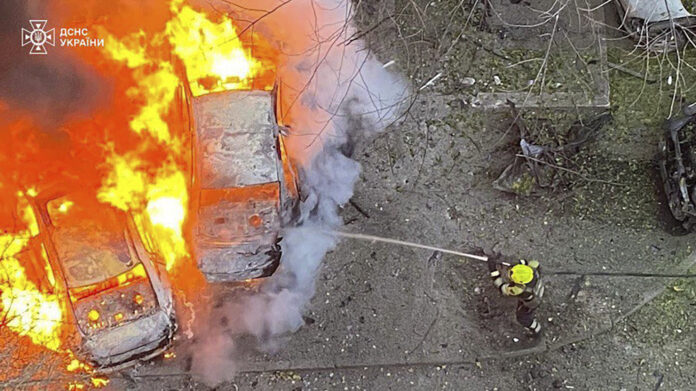Russia launched its most intense aerial offensive on Ukraine in months, targeting energy infrastructure across the nation, leaving at least five dead and causing widespread destruction. The strikes, which spanned cities from Odesa in the south to Rivne in the west, have plunged parts of Ukraine into chaos as winter looms.
Cities Hit as Residents Take Cover
Major cities were under siege, with Kyiv residents forced to shelter in metro stations amid relentless missile and drone attacks. In the Mykolaiv region, a drone strike killed two people and injured six, including two children. In Odesa, two more lives were claimed, while a 17-year-old boy was injured. In the Lviv region, a woman tragically lost her life while in her car, according to local officials.
The Ukrainian Air Force compared the assault to a large-scale attack on August 28, when Russia deployed 127 missiles and 109 drones in a single night.
Widespread Blackouts and Infrastructure Damage
The strikes triggered extensive blackouts, leaving regions like Odesa without heating, water, and electricity. Hospitals have been forced to rely on generators to maintain operations. Ukrainian energy company DTEK confirmed that its thermal power plants suffered severe damage, exacerbating an already fragile energy situation caused by Russia’s repeated targeting of infrastructure since February 2022.
Zelensky Responds to the Crisis
Ukrainian President Volodymyr Zelensky reported that 120 missiles and 90 drones were launched in the latest offensive, with defense forces intercepting over 140 aerial targets. However, critical energy facilities suffered direct hits, leaving parts of the country without power.
In a defiant message, Zelensky stated, “Russian terrorists are once again trying to intimidate us with cold and blackouts, repeating their actions and trying to get results from them.” Authorities are scrambling to restore power in the affected areas.
International Tensions Amid Escalation
The attack comes as Russian President Vladimir Putin remains in contact with some Western leaders. German Chancellor Olaf Scholz defended his recent hour-long phone call with Putin, describing it as “important” despite noting no shift in Russia’s stance on the war. Scholz underscored the need for European leaders to maintain dialogue with Moscow.
Ukraine’s Foreign Minister Andrii Sibyha condemned the strikes, calling for “peace through strength, not appeasement,” referencing Putin’s recent conversations with Western leaders.
Battlefront Updates
On the frontlines, Russia claims to have captured additional settlements in the Donetsk region, though Ukraine has not confirmed these advances. Meanwhile, Moscow prepares for a counteroffensive in the Kursk region, where Kyiv scored its only major military success this year.
As Ukraine braces for its third winter under siege, the nation faces escalating threats to its energy grid and intensified assaults along key battlegrounds. The latest attack underscores the critical juncture in the ongoing conflict.
Russia launched its most intense aerial offensive on Ukraine in months, targeting energy infrastructure across the nation, leaving at least five dead and causing widespread destruction. The strikes, which spanned cities from Odesa in the south to Rivne in the west, have plunged parts of Ukraine into chaos as winter looms.
Cities Hit as Residents Take Cover
Major cities were under siege, with Kyiv residents forced to shelter in metro stations amid relentless missile and drone attacks. In the Mykolaiv region, a drone strike killed two people and injured six, including two children. In Odesa, two more lives were claimed, while a 17-year-old boy was injured. In the Lviv region, a woman tragically lost her life while in her car, according to local officials.
The Ukrainian Air Force compared the assault to a large-scale attack on August 28, when Russia deployed 127 missiles and 109 drones in a single night.
Widespread Blackouts and Infrastructure Damage
The strikes triggered extensive blackouts, leaving regions like Odesa without heating, water, and electricity. Hospitals have been forced to rely on generators to maintain operations. Ukrainian energy company DTEK confirmed that its thermal power plants suffered severe damage, exacerbating an already fragile energy situation caused by Russia’s repeated targeting of infrastructure since February 2022.
Zelensky Responds to the Crisis
Ukrainian President Volodymyr Zelensky reported that 120 missiles and 90 drones were launched in the latest offensive, with defense forces intercepting over 140 aerial targets. However, critical energy facilities suffered direct hits, leaving parts of the country without power.
In a defiant message, Zelensky stated, “Russian terrorists are once again trying to intimidate us with cold and blackouts, repeating their actions and trying to get results from them.” Authorities are scrambling to restore power in the affected areas.
International Tensions Amid Escalation
The attack comes as Russian President Vladimir Putin remains in contact with some Western leaders. German Chancellor Olaf Scholz defended his recent hour-long phone call with Putin, describing it as “important” despite noting no shift in Russia’s stance on the war. Scholz underscored the need for European leaders to maintain dialogue with Moscow.
Ukraine’s Foreign Minister Andrii Sibyha condemned the strikes, calling for “peace through strength, not appeasement,” referencing Putin’s recent conversations with Western leaders.
Battlefront Updates
On the frontlines, Russia claims to have captured additional settlements in the Donetsk region, though Ukraine has not confirmed these advances. Meanwhile, Moscow prepares for a counteroffensive in the Kursk region, where Kyiv scored its only major military success this year.
As Ukraine braces for its third winter under siege, the nation faces escalating threats to its energy grid and intensified assaults along key battlegrounds. The latest attack underscores the critical juncture in the ongoing conflict.


